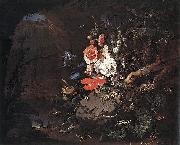Wholesale Oil Painting No Minimum |
|||||||||||
|
|
|||||||||||

|
|||||||||||
|
|
|
||||||||
Abraham Mignon(Frankfurt, June 21, 1640 - Utrecht, March 27, 1679), was a Dutch golden age painter, specialized in flower bouquets. His father, a Frankfurt merchant, placed him under the care of the still-life painter Jacob Marrel, when he was only seven years old. Marrel specialized in flower painting, and found him to be his best pupil. He accompanied Mignon when he moved to the Netherlands about 1660 to work under Jan Davidszoon de Heem at Utrecht. In 1675 he settled there for good when he married the daughter of the painter Cornelis Willaerts (granddaughter of Adam Willaerts). Marrel's stepdaughter Maria Sibylla Merian (1647-1717), daughter of the engraver Matthew Merian, who lived with Marrel and thus studied with Mignon, achieved distinction as a flower painter |
||||||||
|
|
||||||||
Nature as a Symbol of Vanitas
Nature as a Symbol of Vanitas Painting ID:: 76396 |
Date 1665-1679
Medium Oil on canvas
Dimensions 78.7 x 99 cm
cyf Date 1665-1679 Medium Oil on canvas Dimensions 78.7 x 99 cm cyf |
|||||||
|
|
||||||||
|
MIGNON, Abraham Dutch Baroque Era Painter, 1640-1679 Dutch painter, was born at Frankfurt. His father, a merchant, placed him under the still-life painter Jacob Marrel, by whom he was taken to the Netherlands about 1660. He then worked under Jan Davidszoon de Heem at Utrecht, where in 1675 he married the daughter of the painter Cornelis Willaerts. Sibylle Merian (1647-1717), daughter of the engraver Matthew Merian, became his pupil and achieved distinction as a flower painter. He died at Utrecht. Mignon devoted himself almost exclusively to flowers, fruit, birds and other still-life, though at times he also attempted portraiture. His flower pieces are marked by careful finish and delicate handling. His favourite scheme was to introduce red or white roses in the centre of the canvas and to set the whole group of flowers against a dark background. Nowhere can his work be seen to better advantage than at the Dresden Gallery, which contains fifteen of his paintings, twelve of which are signed. Six of his pictures are at the Louvre, four at the Hermitage, and other examples are to be found at the museums of Amsterdam, Nature as a Symbol of Vanitas Date between 1665(1665) and 1679(1679) Medium Oil on canvas cyf |
||||||||
|
|
||||||||
|
Prev Next
|
||||||||
|
|
||||||||
|
Related Paintings to MIGNON, Abraham :. |
||||||||
|
|
||||||||
|
CONTACT US |

